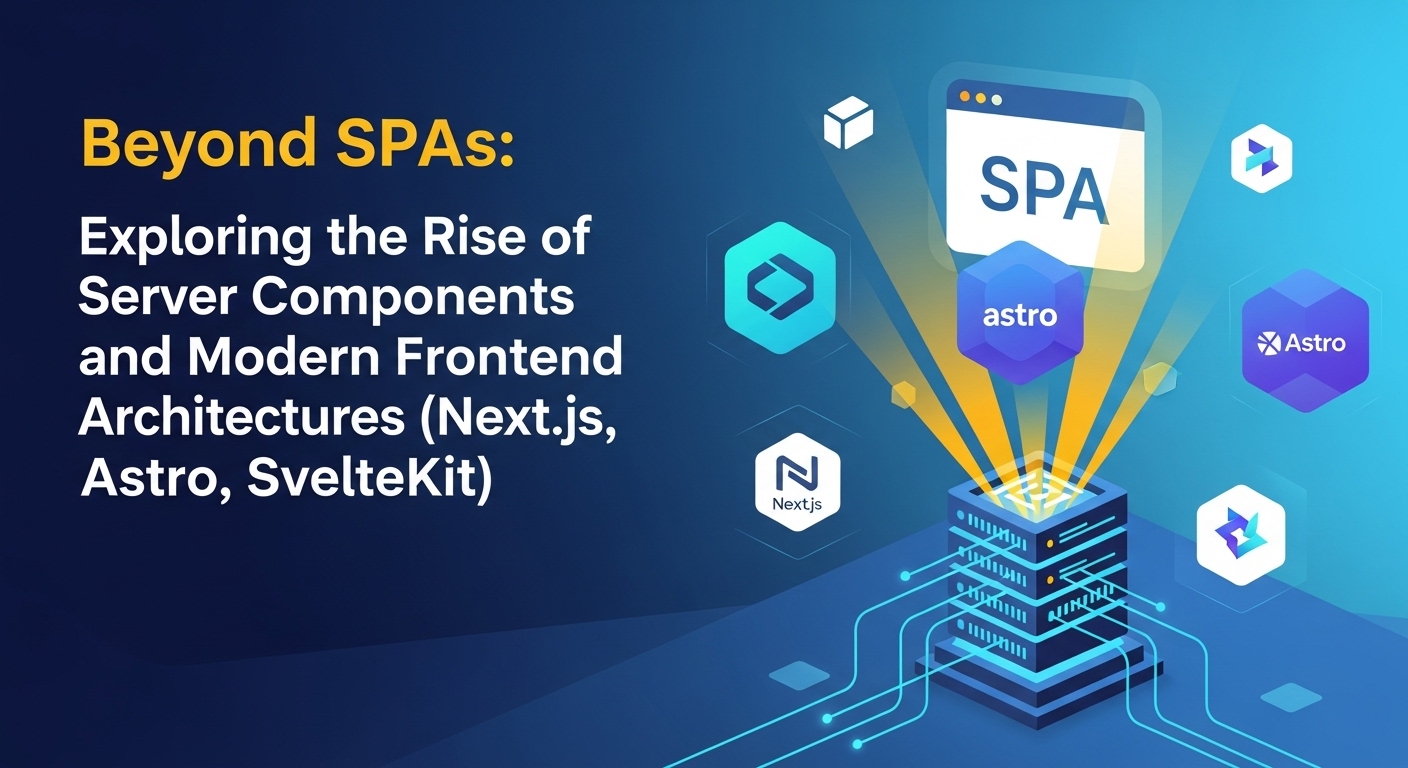Why Core Web Vitals Still Reign Supreme in 2024
In the ever-evolving landscape of frontend development, one constant remains: the user’s insatiable demand for speed. A slow, janky website isn’t just an inconvenience; it’s a direct path to lost conversions, frustrated users, and a plummeting search engine ranking. This is where Google’s Core Web Vitals (CWV) come into play. Far from being just another set of metrics, they are a fundamental framework for quantifying the user experience. In 2024, mastering them isn’t optional—it’s essential for any serious developer looking to deliver top-tier, high-performance web applications. This guide will take you beyond the basics, exploring advanced strategies to conquer CWV and create truly blazing-fast user experiences.
A Quick Refresher on the Core Web Vitals Trio
Before we dive into advanced tactics, let’s quickly re-acquaint ourselves with the key players. These metrics are designed to measure the real-world experience of your users, focusing on loading performance, interactivity, and visual stability.
Largest Contentful Paint (LCP): The Perception of Speed
LCP measures the time it takes for the largest image or text block visible within the viewport to be rendered. In simple terms, it’s the point at which the user feels the main content of the page has loaded. A good LCP score is 2.5 seconds or less. Anything over 4 seconds is considered poor and likely frustrates users waiting for your page to become useful.
From FID to INP: The Evolution of Interactivity
For years, First Input Delay (FID) was the metric for interactivity. However, it only measured the delay of the *first* interaction. In March 2024, Google officially replaced FID with Interaction to Next Paint (INP). INP is a more comprehensive metric that assesses the overall responsiveness of a page by measuring the latency of *all* user interactions (clicks, taps, key presses) throughout the page’s lifecycle. A good INP is 200 milliseconds or less. This shift puts a much greater emphasis on ensuring a consistently smooth and responsive experience, not just a fast initial load.
Cumulative Layout Shift (CLS): The Visual Stability Factor
Have you ever tried to click a button, only for it to move at the last second because an ad loaded above it? That frustrating experience is what CLS measures. It quantifies the sum total of all unexpected layout shifts that occur during the entire lifespan of the page. A good CLS score is 0.1 or less. Maintaining a low CLS is crucial for providing a predictable and non-disruptive user interface.
Advanced Strategies for Optimizing Largest Contentful Paint (LCP)
Getting your LCP under 2.5 seconds often requires more than just compressing images. Here are some advanced techniques to push your LCP into the green.
Prioritize Your LCP Element with `fetchpriority=”high”`
The browser has its own logic for prioritizing resource downloads, but you can give it a powerful hint. Identify your LCP element (often a hero image or a large heading) and give it a `fetchpriority=”high”` attribute. This tells the browser to download this resource before other, less critical ones, significantly speeding up its rendering time.
<img src="/hero-image.webp" fetchpriority="high" alt="Descriptive alt text" />
Serve Next-Gen Image Formats and Use Responsive Images
JPEG and PNG are old news. Modern formats like AVIF and WebP offer superior compression and smaller file sizes with better quality. Use the `
<picture>
<source srcset="/hero-image.avif" type="image/avif">
<source srcset="/hero-image.webp" type="image/webp">
<img src="/hero-image.jpg" alt="Descriptive alt text">
</picture>
Additionally, use the `srcset` and `sizes` attributes to serve appropriately sized images for different screen resolutions, preventing mobile users from downloading massive desktop-sized images.
Eliminate Render-Blocking Resources
JavaScript and CSS files can block the browser from rendering the page until they are downloaded and parsed. Identify non-critical CSS and JS and load them asynchronously using the `defer` or `async` attributes on your script tags. For CSS, consider inlining critical styles directly in the `
` of your HTML to render the above-the-fold content instantly, and load the rest of the stylesheet asynchronously.Conquering Interaction to Next Paint (INP) in 2024
Optimizing for INP is all about keeping the main thread free to respond to user input. This means tackling long-running JavaScript tasks.
Break Down Long Tasks
A ‘long task’ is any piece of JavaScript that blocks the main thread for more than 50 milliseconds. If a user tries to interact with the page during this time, they’ll experience a noticeable delay. The key is to break down these long tasks into smaller, asynchronous chunks. You can use `setTimeout` or `requestAnimationFrame` to yield control back to the main thread, allowing it to process user input.
Embrace Web Workers for Off-Main-Thread Computation
For truly heavy computations, like complex data processing or calculations, don’t even think about running them on the main thread. Web Workers are your best friend. They allow you to run scripts in a background thread, completely separate from the UI thread. This means you can perform intensive tasks without ever freezing the page or affecting its responsiveness.
Optimize Event Listeners and Debounce/Throttle Handlers
Inefficient event listeners can cripple INP. For events that fire rapidly, like `scroll`, `resize`, or `mousemove`, use `debounce` or `throttle` techniques to limit the number of times your handler function is executed. Also, consider using the `{ passive: true }` option in your event listener if you don’t need to call `preventDefault()`, as this can improve scrolling performance.
Eradicating Cumulative Layout Shift (CLS)
A stable UI is a trustworthy UI. Here’s how to ensure your elements stay where they’re supposed to.
Reserve Space: The `aspect-ratio` CSS Property is Your Friend
The most common cause of CLS is images or ads loading and pushing content down. The modern solution is the CSS `aspect-ratio` property. By setting an `aspect-ratio` on your image containers (e.g., `aspect-ratio: 16 / 9;`), the browser reserves the correct amount of space for the image *before* it even loads, eliminating any layout shift when it finally appears.
Master Asynchronous Content Loading
When loading content dynamically (e.g., from an API), don’t just inject it into the DOM and hope for the best. Use skeleton screens or placeholders that mimic the dimensions of the content that will eventually load. This reserves the space upfront, so when the real content arrives, it fills the container without shifting other elements on the page.
Beware of Web Fonts Causing FOIT/FOUT
Web fonts can cause layout shifts. A Flash of Unstyled Text (FOUT) or Flash of Invisible Text (FOIT) occurs when a fallback font is swapped with the web font once it loads. If the two fonts have different dimensions, this swap can cause a significant shift. Mitigate this by using the `font-display: swap;` property in your `@font-face` rule and by using new CSS properties like `size-adjust` to better match the fallback font’s metrics to your web font.
Your Toolkit for Success: Measuring and Monitoring
You can’t improve what you don’t measure. Effective frontend development requires a solid set of tools to diagnose and monitor performance.
Real User Monitoring (RUM) vs. Lab Data
Lab data, gathered from tools like Lighthouse in a controlled environment, is great for debugging. However, Real User Monitoring (RUM) data, collected from actual users in the wild, tells you how your site performs across different devices, networks, and locations. Use a combination of both. Tools like Google’s PageSpeed Insights and the Chrome User Experience Report (CrUX) provide valuable RUM data.
Essential Tools: Chrome DevTools and WebPageTest
Get comfortable with the Performance panel in Chrome DevTools. It allows you to record a performance profile of your page load, identify long tasks, see layout shifts, and analyze the rendering pipeline. For more in-depth analysis, WebPageTest is an invaluable free tool that provides detailed waterfall charts and performance metrics from various locations and devices around the world.
Conclusion: Build Experiences, Not Just Websites
Mastering Core Web Vitals in 2024 is about more than just appeasing Google’s algorithm. It’s a commitment to user-centric frontend development. By focusing on LCP, INP, and CLS, you are directly investing in a better, faster, and more enjoyable experience for your visitors. The advanced strategies we’ve discussed—from prioritizing critical resources and offloading heavy tasks to pre-allocating space for dynamic content—are powerful tools in your arsenal. Implement them, measure their impact, and iterate. By doing so, you’ll not only improve your SEO rankings but also build websites and applications that users love to interact with, turning fleeting visitors into loyal customers.


